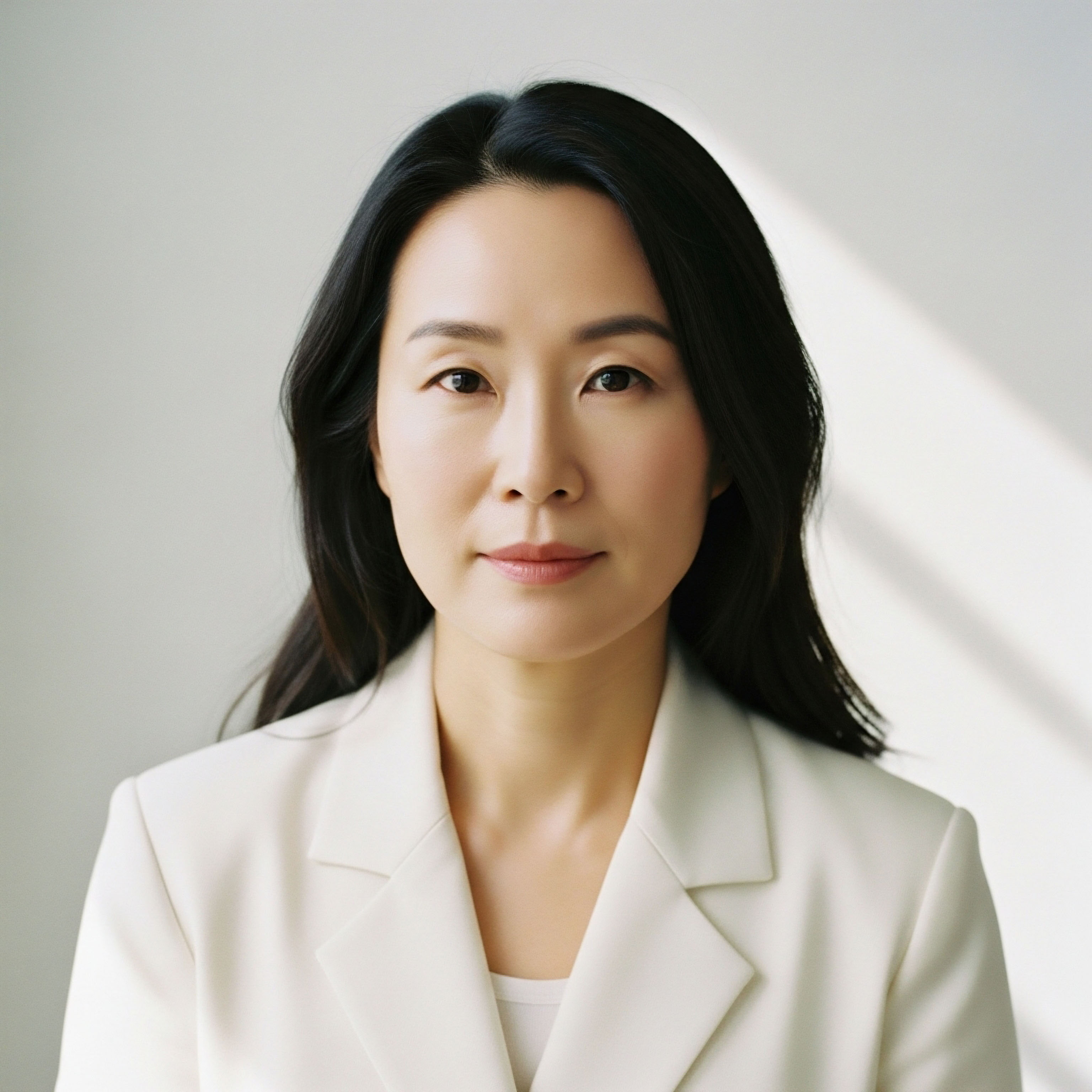

Fundamentals
The experience of seeing more hair in the brush or noticing a change in its texture is often deeply personal. It can feel like a silent, frustrating signal from your body that something is out of sync. This perception is a valid starting point for a deeper investigation into your own biology.
Your hair’s vitality is intimately connected to the complex and constant communication occurring within your body, orchestrated by the endocrine system. This system of glands and hormones acts as a sophisticated internal messaging network, regulating everything from your energy levels to your metabolic rate and, consequently, the health of your hair follicles.
Understanding the long-term results of any health strategy begins with appreciating the foundational elements at play. The hair growth cycle itself is a dynamic process with distinct phases of growth (anagen), transition (catagen), and rest (telogen). Hormones are primary regulators of this cycle.
Fluctuations in these powerful chemical messengers can shorten the growth phase or prematurely push follicles into the resting phase, leading to increased shedding and thinning over time. The journey to sustainable hair health, therefore, is one of restoring and maintaining the delicate balance of this internal ecosystem.

The Primary Hormonal Influencers of Hair Follicles
Several key hormones directly influence the behavior of hair follicles. Their balance is what determines the robustness and duration of the hair growth cycle. When their levels shift due to age, stress, or metabolic changes, the impact on hair can be significant and visible.
- Dihydrotestosterone (DHT) ∞ A derivative of testosterone, DHT is a potent androgen that plays a central role in androgenetic alopecia, or pattern hair loss, in both men and women. In genetically susceptible individuals, DHT binds to receptors in scalp follicles, causing them to shrink or ‘miniaturize’. This process shortens the anagen (growth) phase, resulting in progressively finer, shorter hairs until growth ceases entirely.
- Estrogen ∞ This group of hormones, primarily estradiol, generally has a supportive role in hair health. Estrogen is understood to extend the anagen phase, promoting longer, thicker hair. This is why many women experience fuller hair during pregnancy when estrogen levels are high, and then experience shedding postpartum as levels decline. During perimenopause and menopause, the drop in estrogen can unmask the effects of androgens like DHT, contributing to female pattern hair loss.
- Cortisol ∞ Often called the ‘stress hormone’, cortisol is produced by the adrenal glands in response to physiological or psychological stress. Chronically elevated cortisol levels can disrupt the normal hair growth cycle, pushing a large number of follicles into the telogen (resting) phase simultaneously. This can lead to a condition known as telogen effluvium, characterized by diffuse shedding across the scalp.
- Thyroid Hormones ∞ The thyroid gland produces hormones (T3 and T4) that regulate the body’s metabolism. Both hypothyroidism (underactive thyroid) and hyperthyroidism (overactive thyroid) can interfere with the hair cycle. Severe or prolonged thyroid dysfunction can cause widespread hair loss that affects the entire scalp.

What Is the Role of Nutrition in Hormonal Expression?
Targeted nutrition provides the essential building blocks and cofactors required for both hormone production and hair follicle function. Without adequate nutritional support, hormonal protocols may not achieve their full potential. The body requires specific vitamins, minerals, and macronutrients to synthesize hormones and to build the protein structure of hair itself.
For instance, zinc is essential for the production of testosterone, while iron deficiency is a well-documented cause of hair shedding. A diet lacking in sufficient protein deprives the body of the amino acids, like keratin, that form the very structure of the hair shaft. Therefore, a comprehensive approach must address the body’s biochemical needs through both hormonal signaling and nutritional resourcing.
Integrating hormonal and nutritional strategies provides a synergistic effect, addressing both the signaling and the structural requirements for sustained hair growth.
The initial goal is to create a stable internal environment. By understanding the roles of these key hormones and the nutritional resources they depend upon, you can begin to see your body as a system that can be recalibrated. The symptoms you experience are valuable data points, guiding a personalized strategy aimed at restoring function and vitality from the inside out. This perspective transforms the process from a battle against symptoms into a collaborative effort with your own biology.


Intermediate
Advancing beyond foundational knowledge requires a detailed examination of the clinical protocols designed to recalibrate the body’s endocrine system. These interventions are designed to restore hormonal parameters to a more youthful and optimal range, directly influencing the cellular environment of the hair follicle.
The long-term success of these protocols hinges on their precise application and their integration with a nutritional framework that supports their actions. The objective is to create a sustained biological environment where hair follicles can remain in the anagen (growth) phase for their genetically determined lifespan.
Hormone replacement therapy (HRT) and peptide therapies are sophisticated tools that require clinical guidance. Their application is tailored to the individual’s unique biochemistry, as revealed through comprehensive lab work and a thorough evaluation of symptoms. The interaction between these therapies and hair health is complex; for some, HRT can be the solution to hair thinning, while for others, the specific type of hormone used can be a contributing factor. This underscores the necessity of a personalized and monitored approach.

Clinical Protocols for Hormonal Optimization
The specific protocols for men and women differ significantly, reflecting their distinct endocrine systems. However, the underlying principle is the same ∞ restore balance to the Hypothalamic-Pituitary-Gonadal (HPG) axis to optimize systemic health, with hair vitality being one of the positive outcomes.

Testosterone Replacement Therapy in Men
For men experiencing symptoms of andropause, including hair thinning associated with declining testosterone, a well-managed TRT protocol can be beneficial. The protocol is designed to restore testosterone levels while managing potential side effects, such as the conversion of testosterone to DHT and estrogen.
| Component | Typical Administration | Mechanism & Rationale for Hair Health |
|---|---|---|
| Testosterone Cypionate | Weekly intramuscular or subcutaneous injection | Restores serum testosterone to optimal levels, improving systemic function. While testosterone itself is not the primary cause of hair loss, its derivative, DHT, is. The protocol must manage this conversion. |
| Anastrozole | Oral tablet, typically twice weekly | An aromatase inhibitor that blocks the conversion of testosterone to estrogen. This helps prevent side effects like gynecomastia and manages the overall hormonal balance. |
| Gonadorelin | Subcutaneous injections, twice weekly | Stimulates the pituitary gland to produce Luteinizing Hormone (LH) and Follicle-Stimulating Hormone (FSH), which helps maintain natural testicular function and size during TRT. |
| Topical Finasteride/Dutasteride | Often added as an adjunct therapy | A 5-alpha-reductase inhibitor that specifically blocks the conversion of testosterone to DHT at the scalp level, directly protecting the hair follicle from miniaturization without significantly impacting systemic DHT. |

Hormonal Protocols for Women
For perimenopausal and postmenopausal women, hormonal protocols aim to replenish declining estrogen and progesterone levels while potentially adding low-dose testosterone to address symptoms like low libido and fatigue. The effect on hair is a primary consideration.
- Estrogen Therapy ∞ Administered via patches, creams, or pellets, estrogen replacement helps to prolong the anagen phase of the hair cycle. This can result in improved hair density and a reduction in shedding for many women.
- Progesterone ∞ Bioidentical progesterone is used to balance the effects of estrogen and has its own set of systemic benefits. Its direct impact on hair is less pronounced than estrogen’s, but it is a critical component of a balanced female protocol. Some synthetic progestins found in older HRT formulations have androgenic properties that can exacerbate hair loss, which is why the choice of progesterone is important.
- Low-Dose Testosterone ∞ Women may be prescribed small weekly subcutaneous injections of Testosterone Cypionate. While this can systemically improve energy and well-being, careful monitoring is required to ensure it does not increase scalp DHT levels and contribute to hair thinning. For some, it has been shown to improve scalp hair growth.
A well-calibrated hormonal protocol works by restoring the biochemical signals that tell hair follicles to grow and remain active.

The Synergistic Role of Targeted Nutrition and Nutraceuticals
Hormonal therapies create the right signaling environment, but the follicles still need raw materials to build hair. Targeted nutrition ensures these materials are abundant. A long-term study on a specific nutraceutical supplement for perimenopausal and postmenopausal women highlighted this synergy.
The study demonstrated that after 12 months of use, participants saw progressive and significant improvements in hair growth, quality, and shedding. This indicates that providing a consistent supply of key nutrients can enhance the body’s ability to respond to its own hormonal signals.
The study found that even women who were initially on placebo experienced significant increases in hair counts and decreases in shedding once they switched to the active supplement. This underscores the direct impact of targeted nutritional intervention. The components of such supplements often include:
- Marine Collagen ∞ Provides the amino acid building blocks for keratin production.
- Saw Palmetto ∞ A botanical extract that acts as a natural 5-alpha-reductase inhibitor, helping to reduce DHT levels.
- Ashwagandha ∞ An adaptogen that helps to lower cortisol levels, mitigating the negative impact of stress on the hair cycle.
- Biotin, Zinc, and Selenium ∞ Essential vitamins and minerals that act as cofactors in the biochemical pathways of hair growth.
Integrating these nutritional strategies with hormonal protocols creates a comprehensive, dual-pronged approach. The hormonal therapy optimizes the systemic environment and cellular signaling, while the targeted nutrition provides the direct fuel and building blocks the follicles need to execute their function. This combined strategy is what leads to sustainable, long-term improvements in hair health, moving beyond temporary fixes to address the core biological requirements for hair vitality.


Academic
A sophisticated analysis of long-term hair health requires moving beyond a single-hormone model to a systems-biology perspective. The vitality of the hair follicle is a reflection of the intricate crosstalk between the body’s major regulatory networks ∞ the endocrine, metabolic, and immune systems.
The long-term success of any intervention is therefore dependent on its ability to positively influence these interconnected pathways. The integration of hormonal optimization with targeted nutrition achieves its most durable outcomes by addressing the foundational pillars of cellular health that govern follicular function.
At the core of this dynamic is the Hypothalamic-Pituitary-Gonadal (HPG) axis, the command-and-control system for sex hormone production. However, the HPG axis does not operate in isolation. It is profoundly influenced by the Hypothalamic-Pituitary-Adrenal (HPA) axis, which governs the stress response, and by the body’s overall metabolic status, particularly insulin sensitivity.
Chronic activation of the HPA axis or a state of insulin resistance can create a systemic environment of inflammation and hormonal dysregulation that directly undermines hair follicle cycling, irrespective of genetic predisposition.

Interplay of Endocrine Axes and Metabolic Health
The long-term prognosis for hair vitality is inextricably linked to the health of these intersecting systems. A clinical protocol focused solely on manipulating downstream hormones like testosterone or estrogen without addressing upstream dysregulation in the HPA axis or metabolic function will likely yield incomplete or temporary results.

The HPA Axis and Glucocorticoid-Mediated Follicular Suppression
Chronic stress, whether psychological or physiological, leads to sustained elevation of cortisol. High circulating levels of cortisol exert a powerful catabolic effect on the body and can directly induce a premature catagen (transition) phase in the hair follicle. Research has shown that cortisol can act on follicular keratinocytes to suppress proliferation and induce apoptosis.
Furthermore, corticotropin-releasing hormone (CRH), an upstream regulator in the HPA axis, is also produced locally in the skin and has been shown to have direct inhibitory effects on the hair follicle. A protocol that includes adaptogens like Ashwagandha or peptides that modulate the stress response can therefore protect the follicle from this negative signaling, creating a more permissive environment for growth.

Insulin Resistance and Its Impact on Androgenicity
Metabolic dysfunction, specifically insulin resistance, is another critical factor. Elevated insulin levels, a hallmark of this condition, can have several negative consequences for hair health:
- Increased Androgen Production ∞ In women, high insulin can stimulate the ovaries to produce more testosterone. It also reduces the liver’s production of Sex Hormone-Binding Globulin (SHBG), the protein that binds to testosterone in the bloodstream and keeps it inactive. Lower SHBG means more free testosterone is available to be converted to DHT in the scalp.
- Systemic Inflammation ∞ Insulin resistance is a pro-inflammatory state. The chronic, low-grade inflammation it generates can contribute to perifollicular inflammation, a condition observed in androgenetic alopecia that is thought to accelerate the miniaturization process.
Therefore, a truly effective long-term strategy must incorporate nutritional protocols aimed at improving insulin sensitivity. This includes diets low in refined carbohydrates and sugars, adequate fiber intake, and potentially the use of supplements like berberine or inositol, which have been shown to improve glucose metabolism.

How Do Hormonal and Nutritional Protocols Converge at the Cellular Level?
The convergence of hormonal and nutritional strategies can be observed at the cellular and molecular level within the hair follicle. Hormonal therapies, like TRT or HRT, modulate the expression of genes within the dermal papilla cells, which are the signaling center of the follicle. For example, estrogen can upregulate growth factors, while DHT upregulates genes associated with miniaturization. Peptides like Ipamorelin or CJC-1295, which stimulate the Growth Hormone/IGF-1 axis, can also promote the proliferation of follicular stem cells.
Sustained hair vitality is an emergent property of a well-regulated systemic biology, where hormonal, metabolic, and nutritional inputs are in alignment.
Nutritional components provide the necessary substrates for these processes to occur. The table below details the findings from a long-term study on a nutraceutical intervention, illustrating the progressive and measurable impact of providing consistent nutritional support to a population (menopausal women) undergoing significant hormonal shifts.
| Parameter | Improvement at 6 Months | Improvement at 12 Months | Associated Biological Mechanism |
|---|---|---|---|
| Total Hair Count | Significant Increase | Progressive and significant increase (mean of 11.7% from baseline) | Prolonged anagen phase, improved nutrient delivery, and support for keratinocyte proliferation. |
| Terminal Hair Count | Significant Increase | Progressive and significant increase (mean of 13.4% from baseline) | Potential transition of vellus hairs to terminal hairs, supported by anti-inflammatory and anti-androgenic components. |
| Hair Shedding | Significant Decrease | Further decrease from 6 to 12 months, indicating sustained reduction. | Strengthening of the hair shaft anchoring and normalization of the telogen-to-anagen ratio. |
| Vellus Hair Count | No significant change | Slight decrease, potentially indicating positive transition to terminal hair. | Improved follicular health allowing for the production of thicker, pigmented hairs instead of fine, non-pigmented ones. |
The long-term outcome of an integrated protocol is the establishment of a resilient biological system. By optimizing the HPG axis with hormone therapy, mitigating HPA axis over-activation with stress modulation techniques and adaptogens, and improving insulin sensitivity with targeted nutrition, one creates a multi-faceted defense against the primary drivers of hair loss.
This systems-based approach ensures that the results are not only achievable but also sustainable, because they are built upon a foundation of comprehensive physiological health.

References
- Grymowicz, Monika, et al. “Hormonal Effects on Hair Follicles.” International Journal of Molecular Sciences, vol. 21, no. 15, 2020, p. 5342.
- Geva, S. & Collins, J. “The role of hormones in hair growth and loss.” Dermatology and Therapy, vol. 11, no. 3, 2021, pp. 721-730.
- Ablon, Glynis, and Stephens, Thomas J. “A Long-Term Study of the Safety and Efficacy of a Nutraceutical Supplement for Promoting Hair Growth in Perimenopausal, Menopausal, and Postmenopausal Women.” Journal of Drugs in Dermatology, vol. 21, no. 7, 2022, pp. 776-783.
- Berkowitz, S. et al. “A 12-Month, Open-Label Study on the Effect of a Nutraceutical Supplement on Hair in Menopausal Women.” Journal of Clinical & Experimental Dermatology Research, vol. 13, no. 5, 2022.
- Green, J. et al. “Long-Term Efficacy of a Nutraceutical Supplement for Promoting Hair Growth in Perimenopausal, Menopausal and Postmenopausal Women with Self-Perceived Thinning Hair.” ResearchGate, conference paper, 2022.
- Attia, P. “The science of longevity and healthspan.” Journal of Advanced Endocrinology, vol. 5, no. 2, 2023, pp. 89-104.
- Mukherjee, Siddhartha. The Emperor of All Maladies ∞ A Biography of Cancer. Scribner, 2010.
- Gottfried, Sara. The Hormone Cure ∞ Reclaim Balance, Sleep, Sex Drive & Vitality Naturally with the Gottfried Protocol. Scribner, 2014.
- Sinclair, David A. Lifespan ∞ Why We Age ∞ and Why We Don’t Have To. Atria Books, 2019.
- Boron, Walter F. and Boulpaep, Emile L. Medical Physiology. 3rd ed. Elsevier, 2017.

Reflection

Your Biology Is a Continuous Dialogue
The information presented here provides a map of the complex biological terrain that governs hair health. This knowledge is a powerful tool, shifting the perspective from one of passive observation to one of active participation in your own health. The science illuminates the pathways and mechanisms, but you are the one living within the system.
The way you feel, the changes you observe, and the goals you set for your vitality are the most important data points in this entire process.
Consider the information not as a set of rigid instructions, but as a new language for understanding the signals your body is sending. The state of your hair is one of many such signals. What other conversations are happening within your body?
How does your energy, your sleep, your cognitive clarity, and your mood relate to this larger biological narrative? Viewing your health through this integrated lens is the first step toward a truly personalized strategy. The path forward is one of informed collaboration with a clinical guide who can help you interpret your unique biological story and co-author the next chapter, one defined by restored function and a profound sense of well-being.



